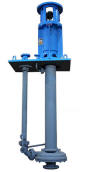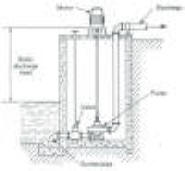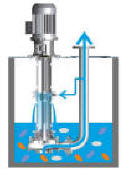




| Pumps - Dynamic pumps - Vertical centrifugal pumps |
| Video |
| Vertical centrifugal pumps are also referred to as cantilever pumps. They utilize a unique shaft and bearing support configuration that allows the volute to hang in the sump while the bearings are outside the sump. This style of pump uses no stuffing box to seal the shaft but instead utilizes a "throttle bushing". |
|
Why vertical centrifugal
pumps are used? When you have a restricted surface area and need a pump that takes up a much smaller footprint, vertical centrifugal pumps will definitely take up less floor space. They are well-suited for liquids with high temperatures and pressures, and the NPSH can be altered to handle a wider range of applications |
|
How does a vertical
centrifugal pump work? Vertical turbine pumps work when water enters the pump at the bottom through a bell-shaped part called the suction bell. From there it moves into the first stage impeller, which raises the water's velocity. At the surface is the pump discharge head, which allows the flow to change direction, toward the discharge pipe. |
|
Where are they used? They are primarily used wherever a submersible pump is not possible, because the flow is above the range of turbines, or because the owner prefers a conventional motor mounted at the top of the pump. They are commonly used in wells that are bored to provide agricultural or turf irrigation, or to provide water supply for municipalities that rely on ground water rather than surface water. They are also used to provide plant make-up water and fire water for industrial plants. |
 |
 |
 |
 |
 |